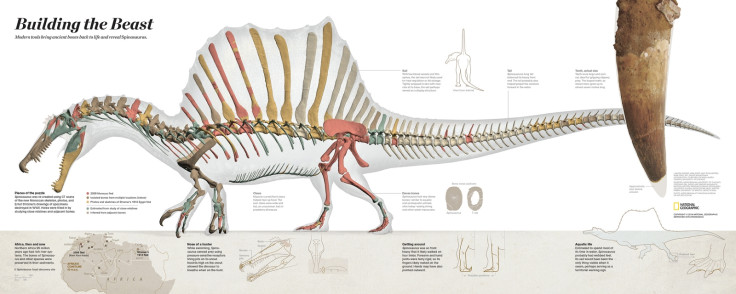Spinosaurus: World's First Semiaquatic Dinosaur was 'Biggest Predator to Roam the Earth'
The world's first semiaquatic dinosaur has been revealed by scientists as a massive predator with giant slanted teeth and blade-like claws.
Spinosaurus aegyptiacus was unveiled by scientists at the National Geographic Society, who described the monstor as being "unlike any other dinosaur" they had ever seen.
Spinosaurus lived about 95 million years ago and was the largest known predatory dinosaur to have roamed the earth. It was over nine feet longer than the world's largest Tyrannosaurus rex specimen.
Their findings, which will be published in the journal Science, reveal how Spinosaurus developed a number of adaptations allowing it to live and hunt in water, as well as on land.
The fossil was found in the Moroccan Sahara. Lead author Nizar Ibrahim, from the University of Chicago, said: "Working on this animal was like studying an alien from outer space; it's unlike any other dinosaur I have ever seen."
Its adaptations included small nostrils in the middle of its skull, allowing it to breathe when partially underwater, giant slanted teeth ideal for fishing and powerful forelimbs with curved, blade-like claws, which were used for hooking or slicing slippery prey.

Scientists believe Spinosaurus could have had webbed feet and enormous dorsal spines that created a "gigantic snail" on its back.
The first evidence for Spinosaurus was discovered over 100 years ago, but all the fossils were destroyed during a bombing in WWII. The area where the latest samples were found would have been home to giant flying reptiles, large sharks, crocodile-like creatures and predatory dinosaurs.
Researchers created a digital model of the skeleton with CT scans, then used this model to create an anatomically precise and life-size 3D replica of the skeleton.
Paleontologist Paul Sereno said: "What surprised us even more than the dinosaur's size were its unusual proportions. We see limb proportions like this in early whales, not predatory dinosaurs."
Cristiano Dal Sasso, from Milan's Natural History Museum, added: "In the last two decades, several finds demonstrated that certain dinosaurs gave origins to birds. Spinosaurus represents an equally bizarre evolutionary process, revealing that predatory dinosaurs adapted to a semiaquatic life and invaded river systems in Cretaceous North Africa."
Spinosaurus will be the cover feature of the October edition of the National Geographic magazine. The dinosaur will also be the subject of a new exhibition at the National Geographic Museum in Washington DC on 12 September and a National Geographic/NOVA film airing on PBS on 5 November.
© Copyright IBTimes 2025. All rights reserved.






















